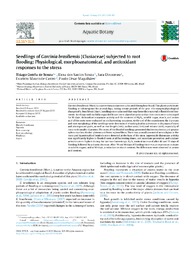Seedlings of Garcinia brasiliensis (Clusiaceae) subjected to rootflooding: Physiological, morphoanatomical, and antioxidantresponses to the stress.
Seedlings of Garcinia brasiliensis (Clusiaceae) subjected to rootflooding: Physiological, morphoanatomical, and antioxidantresponses to the stress.
Author(s): SOUZA, T. C. de; SOUZA, E. dos S.; DOUSSEAU, S.; CASTRO, E. M. de; MAGALHAES, P. C.
Summary: Garcinia brasiliensis (Mart.) is a native Amazonian tree cultivated throughout Brazil. This plant can tolerate flooding or submergence for several days, during certain periods of the year. The morphophysiological changes of G. brasiliensis (Mart.) seedlings were assessed that may favor their survival in flooded environments. Seedlings with six fully expanded leaves were placed in tanks so that their roots were submerged for 90 days. Antioxidant enzymatic activity and the contents of H2O2, soluble sugar, starch, and amino acid of the roots were evaluated on six harvesting occasions. At the end of the experiment, the dry mass and root morphology of the seedlings were determined. Flooding lead to a decrease in dry mass of roots and aboveground parts, as well as root length (58%), surface area (51%) and volume (43%), especially of roots with smaller diameter. The roots of the flooded seedlings presented thicker exodermis and greater xylem number, thicker phloem and fewer xylem fibers. There was a small amount of aerenchyma in the roots and hypertrophied lenticels were detected at the base of the stem. Superoxide dismutase activity was significantly higher in flooded roots at all harvesting times, and ascorbate peroxidase and catalase activities were highest during the last two harvestings. H2O2 content increased after 40 and 55 days of flooding, followed by a drastic decrease. After 70 and 90 days of flooding there was an expressive increase in soluble sugars, and at 90 days, a reduction in starch content. No differences were observed in amino acid content.
Publication year: 2013
Types of publication: Journal article
Unit: Embrapa Maize & Sorghum
Keywords: Hipoxia, Rheedia brasiliensis
Observation
Some of Embrapa's publications are published as ePub files. To read them, use or download one of the following free software options to your computer or mobile device. Android: Google Play Books; IOS: iBooks; Windows and Linux: Calibre.
Access other publications
Access the Agricultural Research Database (BDPA) to consult Embrapa's full library collection and records.
Visit Embrapa Bookstore to purchase books and other publications sold by Embrapa.

